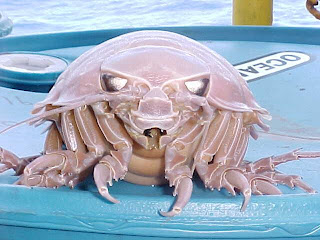Of the nine members of the genus Bathynomus, B. giganteus is the largest. These crustaceans, closely related to shrimp, look like something out of science fiction, but they are in fact real, living creatures that crawl around in the deep sea of the Atlantic and Pacific oceans. Giant Isopods live at depths of over 2,000 feet and can grow to nearly a foot and a half in length!
Like the Giant Squid and the Giant Tube Worm, Giant Isopods are an example of deep sea gigantism, which causes animals on the sea floor to grow far larger than their near-surface counterparts. One thought on why this happens is that the large size helps compensate for the huge amount of water pressure that is placed on the creatures by their deep habitat. Giant Isopods have a rigid exoskeleton that also lets them roll up into a ball to avoid danger.
Giant Isopods are opportunistic, carnivorous feeders, and they have to be! They live in an area where food is scarce, and so they will gorge on whatever they can find. This often includes parts of dead fish and larger marine creatures, and it is believed that they may also hunt slow moving deep sea dwellers as well. They are also capable of surviving for weeks without food, and adaptation that helps them to survive.
Another adaptation comes in the form of their reproductive habits. Giant Isopods lay eggs, rather large ones in fact, and these eggs are incubated in a pouch created by the female. When the eggs hatch, the young have already bypassed the entire larval stage, and look like tiny versions of the adults. This helps them to survive easier early in life.
 |
| (Image Source) |
Giant Isopods are opportunistic, carnivorous feeders, and they have to be! They live in an area where food is scarce, and so they will gorge on whatever they can find. This often includes parts of dead fish and larger marine creatures, and it is believed that they may also hunt slow moving deep sea dwellers as well. They are also capable of surviving for weeks without food, and adaptation that helps them to survive.
Another adaptation comes in the form of their reproductive habits. Giant Isopods lay eggs, rather large ones in fact, and these eggs are incubated in a pouch created by the female. When the eggs hatch, the young have already bypassed the entire larval stage, and look like tiny versions of the adults. This helps them to survive easier early in life.
Comments
Post a Comment